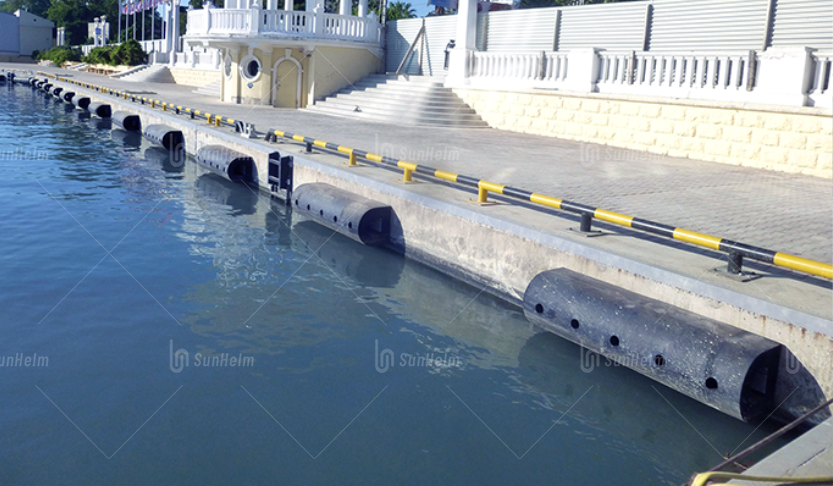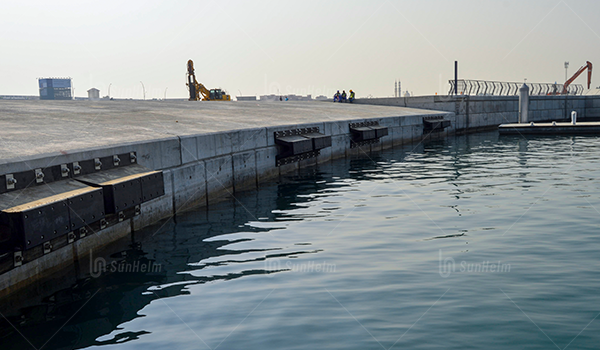When it comes to protecting vessels and port structures, rubber fenders are the first line of defense. Over time, constant compression, UV exposure, and seawater corrosion reduce their performance. Eventually, you’ll need to replace them.
But here’s the big question: when replacing rubber fenders, do you really need to replace all the accessories too? Or can some components be inspected, approved, and reused to save costs without compromising safety?
In this guide, we’ll break it all down — from which parts are considered consumables to which components you can reuse after a proper inspection.

Why Accessories Matter When Replacing Rubber Fenders
A rubber fender system is more than just the rubber body. It’s an entire assembly — rubber units, steel panels, chains, shackles, bolts, and more. If you only replace the rubber and ignore the condition of other accessories, you could face:
- Reduced energy absorption — Loose bolts or deformed panels can make the system less effective.
- Safety risks — Worn chains or shackles may fail under load.
- Higher maintenance costs — Skipping inspections could lead to unexpected failures and costly downtime later.
In short, evaluating your accessories when replacing rubber fenders isn’t optional — it’s critical.
Common Accessories in Rubber Fender Systems
Depending on the type of rubber fender, the accessory list can vary. Let’s break it down:
1. Panel-Type Fender Systems
Used for cone, cell, and cylindrical fenders on large berths:
- Steel panels
- UHMW-PE frontal pads
- Chains, shackles, swivels
- Anchor bolts and backing plates
- Shear stoppers and anti-pull-out devices
2. Bolt-Mounted Fender Systems
Common for arch, D-type, and W-type fenders:
- Backing plates
- T-head bolts or chemical anchors
- End caps and seals
3. Hanging Fender Systems
For floating structures or special applications:
- Brackets, clamps, and support blocks
- Cushion pads and spacers
Replace or Reuse? Here’s the Quick Guide
| Component | Recommended Action | Reuse Conditions | Notes |
|---|---|---|---|
| Rubber body | Always replace | N/A | Performance declines over time |
| UHMW-PE pads | Always replace | N/A | High wear rates affect friction |
| Seals & end caps | Always replace | N/A | Low-cost consumables |
| Chains & shackles | Reuse if approved | No cracks, minimal corrosion (<10%), passes load tests | Replace pins if worn |
| Steel panels | Reuse if approved | No deformation or cracks, coating can be renewed | Always reapply anti-corrosion coating |
| Anchor bolts & plates | Reuse if tested | Must pass pull-out test (>90% design strength) | Replace if corroded or stripped |
| Embedded steel parts | Usually keep | Pass structural inspection | Saves time and avoids civil work |
How to Inspect Fender Accessories Before Reuse
If you want to reuse parts safely, don’t skip these checks:
- Visual Inspection
Look for cracks, deep corrosion, or deformation in panels, chains, and shackles. - Coating & Corrosion Check
Measure corrosion depth and recoat if needed. - Mechanical Testing
- Load test chains and shackles.
- Perform pull-out tests on anchor bolts.
- Thread & Torque Check
Inspect bolts for stripped threads and confirm torque values during reinstallation.
These tests help you confidently decide whether to reuse or replace without guessing.
Replacement Recommendations by Fender Type
Panel-Type Systems
- Steel panels → Reuse if structurally sound; recoat for corrosion protection.
- UHMW-PE pads → Replace; high-friction parts wear out quickly.
- Chains, shackles, swivels → Reuse if wear and corrosion are within limits, but always replace pins.
- Anchor bolts & backing plates → Keep if they pass pull-out testing, otherwise replace.
Bolt-Mounted Fenders
- Backing plates → Reuse if undamaged; recoat to extend lifespan.
- T-head bolts & chemical anchors → Generally replace; especially chemical anchors that can’t be retested.
- End caps & seals → Replace to maintain waterproofing and performance.
Balancing Cost and Safety
Reusing accessories can save money and time — but only if done right. Consider:
- Cost savings: Reusing heavy steel panels or backing plates reduces material and labor costs.
- Safety concerns: A single failed chain or bolt can lead to significant vessel and berth damage.
- Best practice: Replace all high-risk consumables. Inspect structural components carefully, then reuse only if they pass testing.
Extending Accessory Lifespan
If you want to maximize future reuse potential, focus on corrosion protection and preventive maintenance:
- Use hot-dip galvanizing or zinc-rich primers for steel parts.
- Apply anti-seize paste on bolts for easier future removal.
- Schedule annual inspections for chains, shackles, and fasteners.
Small investments in maintenance today can save you big costs during the next fender replacement cycle.
Frequently Asked Questions (FAQ)
Q1. Can I reuse anchor bolts when replacing rubber fenders?
Yes, but only after pull-out testing confirms the holding force meets design specs.
Q2. Do I always need to replace the steel panels?
Not always. If the panel has no structural damage and the coating is renewed, it can be reused.
Q3. How often should chains and shackles be replaced?
Inspect them every 3–5 years. Replace if wear exceeds 10% or if corrosion is severe.
Q4. Does reusing accessories affect warranty coverage?
It can. If you want full warranty protection, check with your supplier before reusing any parts.
Final Thoughts
When replacing rubber fenders, you don’t have to replace everything blindly. Rubber bodies, UHMW-PE pads, seals, and other consumables should always be replaced. But steel panels, chains, shackles, and anchor bolts can often be reused — provided they pass inspection and testing.
By following a structured assessment, you can ensure docking safety, reduce maintenance costs, and minimize downtime.


